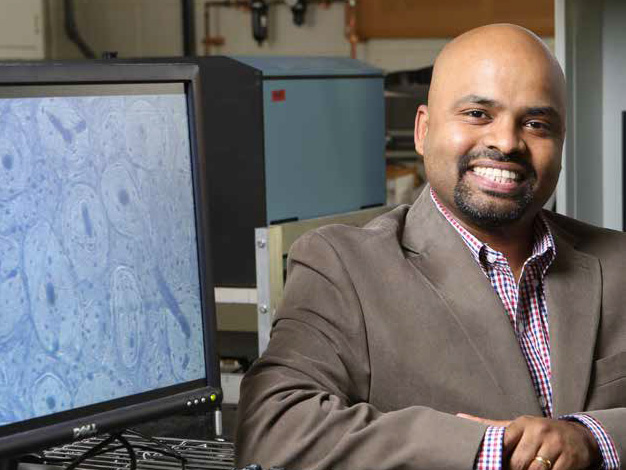
As a postdoctoral research associate at the University of Illinois at Urbana- Champaign, Samuel often heard her talk about her husband’s knee replacements. One was successful; the other was not. The joint never regained full motion.
That sparked not only Samuel’s compassion, but his curiosity.
Some might consider that unusual. At first glance, surgery and bone structure seem far afield of Samuel’s chief focus: the place where advanced material systems and micro-/nanomanufacturing meet. But Samuel was quick to see the link.
“I think of surgery as a manufacturing operation,” said the assistant professor in MANE. “To me, the surgery table is the same as a factory table. So I began to wonder whether my knowledge of materials and manufacturing could be useful in this area.”
A Gap in the Research
While reviewing the literature, Samuel noticed an aspect of the topic that had received little attention. Biomedical engineers had thoroughly investigated the microstructure of bone; doctors focused their interest on surgical results and evaluation of specific tools. Almost no one had connected the two. And that connection was vital.
“When cutting different materials, you get different responses,” Samuel explained. “If we could understand the effect of certain cuts on different bone microstructures, we could make advances in cutting and drilling tools to better suit individual patients—which could result in higher success rates and faster recovery times.”
Clearly the National Science Foundation (NSF) saw merit in Johnson’s thinking: he was honored with the agency’s prestigious CAREER Award in 2014 for taking this area in an entirely new direction.
The Right Cut for the Right Bone
Many surgical candidates will see merit in the research too. To take just one procedure, knee replacements in the U.S. number 600,000 per year, and about 10 percent of them do not achieve optimal results. Many other procedures also require the cutting and drilling of bone. Moreover, bone microstructures not only vary from person to person, but also change over time, particularly in their degree of mineralization. As a result, a perfect cut for one patient could be a disaster for another.
At the heart of the CAREER Award research, Samuel’s team characterizes and maps the effect of various cuts on age-varying animal bones. Then, using modeling techniques, they develop optimum cutting tool geometries and tool paths for various bone types. If all goes according to plan, the results will lead to a new generation of bone machining tools and surgery planning techniques.
The research may also produce ideas for customizing current tools. “We’re not necessarily interested in inventing entirely new tools,” Samuel said. “For instance, we could enhance existing saws with different blade geometries for different cutting motions.”
The team plans to look into such bone microstructural components as osteon fibers, interstitial matrices, cement lines, and voids. Of 3D Printers and Lego Machines According to Samuel, many doctors shy away from considering such patient-specific approaches. Surgery is already a complex, delicate process; tailoring steps to individual patients may introduce too much complexity. Hence the second part of Samuel’s research: creating a perfect 3D-printed copy of the surgical site for doctors to practice on before the actual procedure.
“Once we understand the materials aspects of bone properties and microstructures, then we can create the ability to train doctors in patient-specific surgery protocols via 3D printing,” Samuel said.
For the educational element of the CAREER Award, Samuel has met a difficult challenge—getting middle and high school students excited about manufacturing—with one of the world’s greatest inspirations of childhood creativity: the Lego. Samuel’s lab features a variety of common machines built from Lego blocks, and they are having the desired effect.
“Whenever I’ve had middle schoolers in the lab for a presentation, they couldn’t be bothered with the conventional machines, however fancy,” Samuel said. “But they go straight for the Lego machines. One of the big challenges facing U.S. manufacturing is that young people aren’t interested —so we’re hoping that playing with the Lego machines might inspire them to consider a manufacturing career.”
This kind of mentoring is second nature to Samuel, thanks in part to a solemn charge from one of his Ph.D. advisors. “Three weeks before he passed away, Professor Richard DeVor said to me, ‘Johnson, we trained you. Now you need to train your students,’” Samuel recalled. “Those were his last spoken words to me. That’s the biggest thing that keeps me going.”




